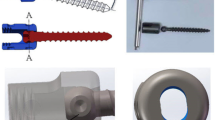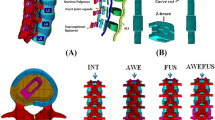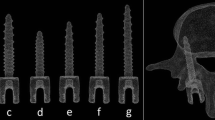Abstract
Purpose
Pedicle-screw-based dynamic implants are intended to preserve intervertebral mobility while releasing certain spinal structures. The aim of the study was to determine the as yet unknown optimal stiffness value of the longitudinal rods that fulfils best these opposing tasks.
Methods
A finite element model of the lumbar spine was used which includes the posterior implant at level L4/5. More than 250 variations of this model were generated by varying the diameter of the longitudinal rods between 6 and 12 mm and their elastic modulus between 10 MPa and 200 MPa. The loading cases flexion, extension, lateral bending and axial rotation were simulated. Evaluated optimization criteria were the ranges of motion, forces in the facet joints, posterior bulgings of the intervertebral disc and the intradiscal pressures. Various objective functions were evaluated.
Results
The results show that the objective values depend more on the axial stiffness of the rods than on bending and torsional stiffness, rod diameter and elastic modulus. The optimal stiffness value for most of the investigated objective functions is approximately 50 N/mm and is achieved, e.g. using a rod diameter of 6 mm and an elastic modulus of 50 MPa. The design with the least axial stiffness was the best one with regard to the mobility. The forces in the facet joints and the intradiscal pressures were reduced mostly by an implant with the highest axial stiffness. When minimal posterior disc bulging was the criterion, the optimal axial stiffness was also approximately 50 N/mm.
Conclusions
The optimal axial stiffness of a pedicle-screw-based motion preservation implant for the lumbar spine is approximately 50 N/mm.




Similar content being viewed by others
References
Ahn YH, Chen WM, Lee KY, Park KW, Lee SJ (2008) Comparison of the load-sharing characteristics between pedicle-based dynamic and rigid rod devices. Biomed Mater 3:44101
Rohlmann A, Nabil Boustani H, Bergmann G, Zander T (2010) Effect of a pedicle-screw-based motion preservation system on lumbar spine biomechanics: a probabilistic finite element study with subsequent sensitivity analysis. J Biomech 43:2963–2969
Stoll TM, Dubois G, Schwarzenbach O (2002) The dynamic neutralization system for the spine: a multi-center study of a novel nonfusion system. Eur Spine J 11(Suppl. 2):S170–S178
Wilke HJ, Heuer F, Schmidt H (2009) Prospective design delineation and subsequent in vitro evaluation of a new posterior dynamic stabilization system. Spine 34:255–261
Schmidt H, Heuer F, Wilke HJ (2009) Which axial and bending stiffnesses of posterior implants are required to design a flexible lumbar stabilization system? J Biomech 42:48–54
Rohlmann A, Burra NK, Zander T, Bergmann G (2007) Comparison of the effects of bilateral posterior dynamic and rigid fixation devices on the loads in the lumbar spine: a finite element analysis. Eur Spine J 16:1223–1231
Zander T, Rohlmann A, Calisse J, Bergmann G (2001) Estimation of muscle forces in the lumbar spine during upper-body inclination. Clin Biomech 16:S73–S80
Rohlmann A, Bauer L, Zander T, Bergmann G, Wilke HJ (2006) Determination of trunk muscle forces for flexion and extension by using a validated finite element model of the lumbar spine and measured in vivo data. J Biomech 39:981–989
Zander T, Rohlmann A, Bergmann G (2009) Influence of different artificial disc kinematics on spine biomechanics. Clin Biomech 24:135–142
Zander T, Rohlmann A, Bock B, Bergmann G (2007) Biomechanische Konsequenzen von verschiedenen Positionierungen bewegungserhaltender Bandscheibenimplantate. Eine Finite-Elemente-Studie an der Lendenwirbelsäule. Orthopade 36:205–211
Rohlmann A, Zander T, Rao M, Bergmann G (2009) Applying a follower load delivers realistic results for simulating standing. J Biomech 42:1520–1526
Dreischarf M, Rohlmann A, Bergmann G, Zander T (submitted) Optimised in vitro applicable loads for the simulation of lateral bending in the lumbar spine
Dreischarf M, Rohlmann A, Bergmann G, Zander T (2011) Optimised loads for the simulation of axial rotation in the lumbar spine. J Biomech 44:2323–2327
Rohlmann A, Zander T, Rao M, Bergmann G (2009) Realistic loading conditions for upper body bending. J Biomech 42:884–890
Kettler A, Rohlmann F, Ring C, Mack C, Wilke HJ (2011) Do early stages of lumbar intervertebral disc degeneration really cause instability? Evaluation of an in vitro database. Eur Spine J 20:578–584
Rohlmann A, Zander T, Schmidt H, Wilke H-J, Bergmann G (2006) Analysis of the influence of disc degeneration on the mechanical behaviour of a lumbar motion segment using the finite element method. J Biomech 39:2484–2490
Ueno K, Liu YK (1987) A three-dimensional nonlinear finite element model of lumbar intervertebral joint in torsion. J Biomech Eng 109:200–209
Shirazi-Adl A, Ahmed AM, Shrivastava SC (1986) Mechanical response of a lumbar motion segment in axial torque alone and combined with compression. Spine 11:914–927
Eberlein R, Holzapfel GA, Schulze-Bauer CAJ (2000) An anisotropic model for annulus tissue and enhanced finite element analysis of intact lumbar disc bodies. Comp Meth Biomech Biomed Eng 4:209–229
Nolte LP, Panjabi MM, Oxland TR (1990) Biomechanical properties of lumbar spinal ligaments. In: Heimke G, Soltesz U, Lee AJC (eds) Clinical Implant Materials Advances in Biomaterials. Elsevier, Heidelberg, pp 663–668
Sharma M, Langrana NA, Rodriguez J (1995) Role of ligaments and facets in lumbar spinal stability. Spine 20:887–900
Acknowledgments
This study has been supported in part by Spinelab AG, Winterthur, Switzerland and Deutsche Forschungsgemeinschaft, Bonn, Germany.
Conflict of interest
The sponsors were not involved in the analysis and interpretation of any data, in the writing of the manuscript; or in the decision to submit the manuscript for publication.
Author information
Authors and Affiliations
Corresponding author
Rights and permissions
About this article
Cite this article
Rohlmann, A., Zander, T., Bergmann, G. et al. Optimal stiffness of a pedicle-screw-based motion preservation implant for the lumbar spine. Eur Spine J 21, 666–673 (2012). https://doi.org/10.1007/s00586-011-2047-4
Received:
Revised:
Accepted:
Published:
Issue Date:
DOI: https://doi.org/10.1007/s00586-011-2047-4




